Nope, not at all! I’m actually new-ish to this side of music, so I appreciate any corrections when I’m wrong. I was copying the scale over and I think I meant to add a sharp to B and my brain jumbled that to “add B sharp”.
I feel you!! It’s definitely a weird and bizarre world that’s hard to navigate. I struggle a lot with anything above a slightly-higher-than-basic level, I really only know enough to not be floundering when my vocalist is telling me what the changes in a song are haha

I’m back with another hot take, and before I begin I have to say that I’m actually guilty of starting this trend myself. So consider this my attempt to correct some misconceptions I may have spread some years ago on Monochrome Heaven in an attempt to:
- Teach people about what MP3 quality means and why it’s important
- Spot Demon Android’s shit YouTube rips.
We succeeded at that but in exchange I believe that we have promoted a belief that spectrographs tell all. Spectrographs is basically a program that analyses music wave forms for you. Spek is a popular one and it’s free, and for the rest of this post whenever I say Spek just replace it with the full word. It’s much faster that way.
The reason why Spek is useful is because of the particular pipeline of converting from lossless WAV to MP3, then taking the MP3 and turning it into a video (this is a conversion on the audio itself so you lose quality here), then taking that video and throwing it onto YouTube. This compresses the video and audio to YouTube standard, which is 126 kbps AAC. This is actually a bigger conversion than it seems, because AAC prioritizes different frequencies to preserve and throw out than MP3. Then, you go to some site that can rip the MP3 out of the video for you, which is doing another conversion. By the time you have the file back in MP3, all the quality is out the window and it’s very obvious on Spek. It’s a line that cuts around 16khz.
But just because there’s a line at 16khz doesn’t mean that it’s a YouTube rip. Sometimes, CDs just come that way. A good example is “Scene in the misereal” by -OZ-. Below are four graphs of the same track in different qualities.
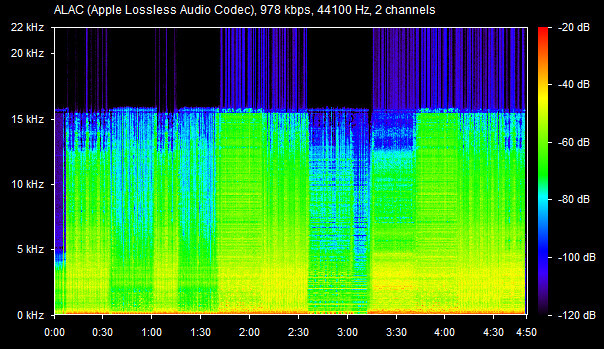
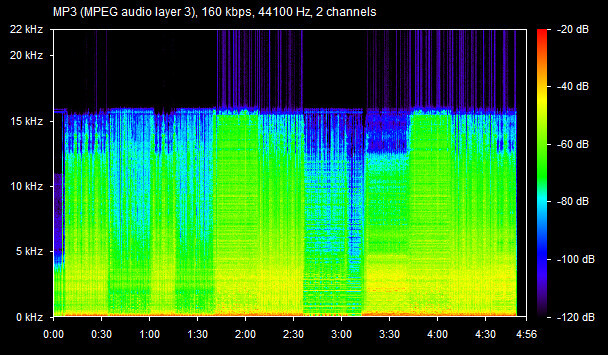
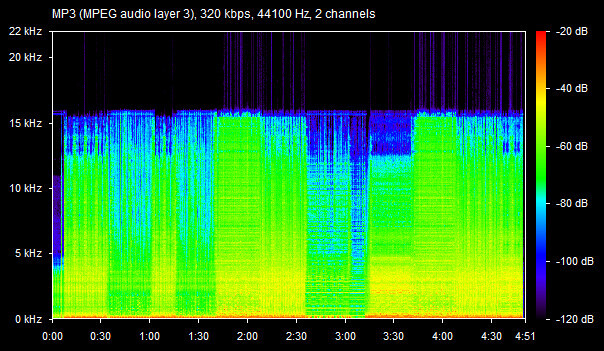
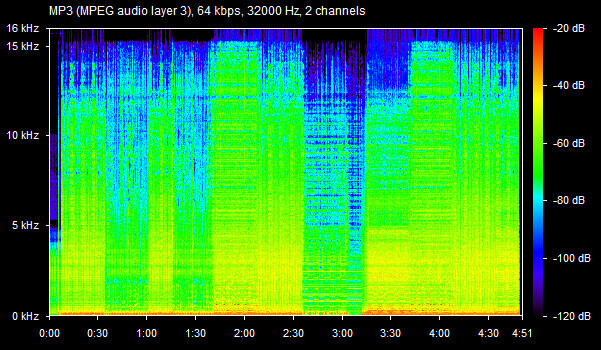
The first is the lossless file, the second is the original rip at 160kbps MP3, the third is a transcode of the original rip from 160 to 320 MP3, the fourth is a transcode of the third down to 64kbps MP3. They all look exactly the same and that’s the point - the graph only tells one part of the picture. Hell, if you aren’t paying attention and you don’t read the axes, you could be convinced that the bottom is “better”. If I was especially devious, I could photoshop the bottom graph onto one of the pictures with the top axis, and this would look “correct” and no one would be quick to tell the difference unless someone else with the CD performed the same steps and realized the inconsistency.
Pictures say whatever you want them to say.
What it comes down to really is how the MP3 encoder does the job. The goal is to remove frequencies it thinks you won’t notice are gone, but it doesn’t do this in an organized fashion really. The MP3 encoder takes data out from frequencies across all ranges to shrink the file. It prioritizes the extremes, but if you set the quality to anything below 192kbps the algorithm has to get aggressive and starts removing enough data from all frequencies for you to notice. No matter what, it’s throwing data out from the mid range too. That’s why even though the 64 kbps graph looks just the same as the rest if you scale it out, it sounds like absolute shit if you listen to it.
Graphs are good, but statistics are easily manipulated. Trust your gut and your ear. If you really want proof that the rip came from a CD, ask for a LOG + CUE of the CD. Anyone who has used Exact Audio Copy can generate these for you pretty quickly - and if you’re using anything else, stop and start using EAC. Other than that, you have no guarantee that what you’re getting comes directly from the CD. LOG + CUE is a much more reliable indicator of quality than Spek. LOG + CUE is easy to verify and hard to fake, which is what makes it so attractive. It only takes a few minutes to generate. If there’s ever any doubt to the authenticity of a rip, anyone else with the CD can generate LOG + CUE and compare. The hashes should be identical.
Here is an example of a LOG from a SCREW rip I did.
Exact Audio Copy V1.6 from 23. October 2020
EAC extraction logfile from 23. February 2022, 21:32
SCREW / TOUR09 X-RAYS OF SCREW AND ANAPHYLAXIS
Used drive : TSSTcorpCDDVDW TS-L633C Adapter: 1 ID: 0
Read mode : Secure
Utilize accurate stream : Yes
Defeat audio cache : No
Make use of C2 pointers : No
Read offset correction : 6
Overread into Lead-In and Lead-Out : No
Fill up missing offset samples with silence : Yes
Delete leading and trailing silent blocks : No
Null samples used in CRC calculations : Yes
Used interface : Native Win32 interface for Win NT & 2000
Gap handling : Appended to previous track
Used output format : User Defined Encoder
Selected bitrate : 1024 kBit/s
Quality : High
Add ID3 tag : No
Command line compressor : C:\Program Files (x86)\Exact Audio Copy\Flac\flac.exe
Additional command line options : -8 -e -p -V -T "ARTIST=%artist%" -T "TITLE=%title%" -T "ALBUM=%albumtitle%" -T "DATE=%year%" -T "TRACKNUMBER=%tracknr%" -T "GENRE=%genre%" -T "PERFORMER=%albuminterpret%" -T "COMPOSER=%composer%" %haslyrics%--tag-from-file=LYRICS="%lyricsfile%"%haslyrics% -T "ALBUMARTIST=%albumartist%" -T "DISCNUMBER=%cdnumber%" -T "TOTALDISCS=%totalcds%" -T "TOTALTRACKS=%numtracks%" -T "COMMENT=%comment%" %source% -o %dest%
TOC of the extracted CD
Track | Start | Length | Start sector | End sector
---------------------------------------------------------
1 | 0:00.00 | 3:04.65 | 0 | 13864
2 | 3:04.65 | 2:57.39 | 13865 | 27178
3 | 6:02.29 | 3:35.40 | 27179 | 43343
4 | 9:37.69 | 3:36.27 | 43344 | 59570
5 | 13:14.21 | 4:16.46 | 59571 | 78816
6 | 17:30.67 | 4:20.73 | 78817 | 98389
7 | 21:51.65 | 3:59.01 | 98390 | 116315
8 | 25:50.66 | 3:58.70 | 116316 | 134235
9 | 29:49.61 | 4:17.31 | 134236 | 153541
Track 1
Filename C:\Users\zeus\Downloads\01 - DEADLY SILENCE.wav
Pre-gap length 0:00:02.00
Peak level 99.9 %
Extraction speed 1.8 X
Track quality 100.0 %
Copy CRC D76CA9AA
Track not present in AccurateRip database
Copy OK
Track 2
Filename C:\Users\zeus\Downloads\02 - アナフィラキシー.wav
Peak level 100.0 %
Extraction speed 2.0 X
Track quality 100.0 %
Copy CRC D0DBAF7C
Track not present in AccurateRip database
Copy OK
Track 3
Filename C:\Users\zeus\Downloads\03 - VANQUISH.wav
Pre-gap length 0:00:00.09
Peak level 100.0 %
Extraction speed 2.2 X
Track quality 100.0 %
Copy CRC DFB6ADB5
Track not present in AccurateRip database
Copy OK
Track 4
Filename C:\Users\zeus\Downloads\04 - END IN TRAGEDY.wav
Pre-gap length 0:00:00.60
Peak level 99.8 %
Extraction speed 2.4 X
Track quality 100.0 %
Copy CRC 1A59FAA4
Track not present in AccurateRip database
Copy OK
Track 5
Filename C:\Users\zeus\Downloads\05 - VAIN HOPE.wav
Pre-gap length 0:00:00.60
Peak level 99.8 %
Extraction speed 2.5 X
Track quality 99.9 %
Copy CRC CAA828F0
Track not present in AccurateRip database
Copy OK
Track 6
Filename C:\Users\zeus\Downloads\06 - CELESTIAL BLISS.wav
Pre-gap length 0:00:01.60
Peak level 99.9 %
Extraction speed 2.7 X
Track quality 100.0 %
Copy CRC E180AF0F
Track not present in AccurateRip database
Copy OK
Track 7
Filename C:\Users\zeus\Downloads\07 - VEGAS.wav
Pre-gap length 0:00:02.10
Peak level 99.9 %
Extraction speed 2.8 X
Track quality 99.9 %
Copy CRC 8AE22201
Track not present in AccurateRip database
Copy OK
Track 8
Filename C:\Users\zeus\Downloads\08 - REND-LOOP.wav
Pre-gap length 0:00:00.10
Peak level 98.8 %
Extraction speed 3.0 X
Track quality 100.0 %
Copy CRC 89549DE5
Track not present in AccurateRip database
Copy OK
Track 9
Filename C:\Users\zeus\Downloads\09 - THICK-SKINNED†CONTRADICTION.wav
Pre-gap length 0:00:01.60
Peak level 99.9 %
Extraction speed 3.2 X
Track quality 100.0 %
Copy CRC 38FC9811
Track not present in AccurateRip database
Copy OK
None of the tracks are present in the AccurateRip database
No errors occurred
End of status report
---- CUETools DB Plugin V2.1.6
[CTDB TOCID: r1o800VJaQPgYdFKpNABRROP.7o-] disk not present in database
Submit result: r1o800VJaQPgYdFKpNABRROP.7o- has been uploaded
==== Log checksum 60B2469CB4C3F26A0643E0C0AE712E76922DCEFFB5F6672661E3D119EF448E36 ====
Good luck faking this.
You cannot generate these using iTunes and in general, I would not use iTunes to rip CDs. iTunes has very few options for you to customize how it is ripped, and unless you uncheck a particular setting it applies a low-pass filter over everything it rips - lossless or not - which means that whatever is generated is not a bit-perfect copy of what’s on the disc. That may or may not be important to you, but since you can’t generate a LOG + CUE I think it’s irrelevant. If I’m going through the effort of ripping something in lossless, it’s because I want to preserve the contents as best as I can, and I do not want any filters applied, even if I won’t notice.
tl;dr - Stop using Spek. Start using EAC. Ask for LOG + CUE if you have doubts about authenticity. ![]()
EDIT: If you are on Mac, use X Lossless Decoder. EAC isn’t available for Mac but this will do the same thing.
Zeus here ta edjucate. You got me with the last graph. Had to go check it again after you pointed out what it was really showing.
Interesting take on this. I have worked to spek and ripping for a little while and start to notice some things about sound in relation to graph on spek. This is how i sometime am able to enhance certain audio files. This is all dependent on how well the audio was made prior to the uploads and involve production quality. Which i agree about your point on this but wanted to add somethings.
I somewhat agree about your point on youtube rips are all 126 kbps. Yes of course they are terrible. Some spek to 320kbps on graphs and sound like true lossy audio but these cases are rare/uncommon. This kinda also goes back to my point about production which i agree on. There are some other complexity worth mentioning.
For example this was a sample i took from youtube. The song is Delacroix - アニマ (Anima)
While listening i noted the sound quality and graph both look and sound decent. As you stated if a program is used here the conversion the gets brought down even more but this sample was taken straight off youtube no manipulation involved. Also note the colors on the side are actually important when distinguishing sound quality and volume. Which ill explain in a moment.
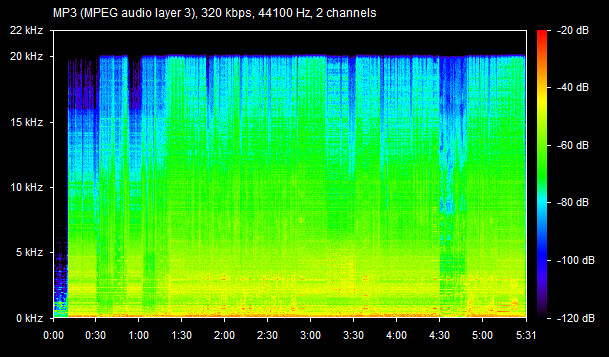
In the OZ rips that are true rips. This track in particular has a lot of green which on a listening perspective is considered balanced audio. The best type of rip is something that is more on the 60 db range to 80 db ranges but more toward 80 db range. 100 db being the the worst quality but more louder and the quality gets worse. Note the cyan green and blue colors mixed in.
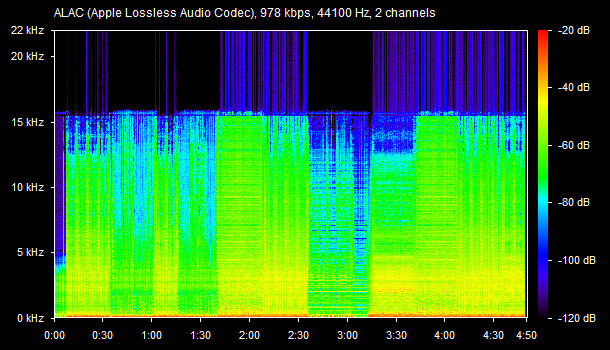
Now lets take a look at something like. Shellmy last snow. This rip that looks transcoded due to a spectral cut or line at the 16 khz mark but it isnt. Rips like these are similar to enhanced audio on the production side. The reason on how i know this is because of a little experiment i did with amplifying audio and came to the conclusion that these rips previously sounded low but were enhanced professionally probably to save money or time etc… and these mostly happen with limited releases.
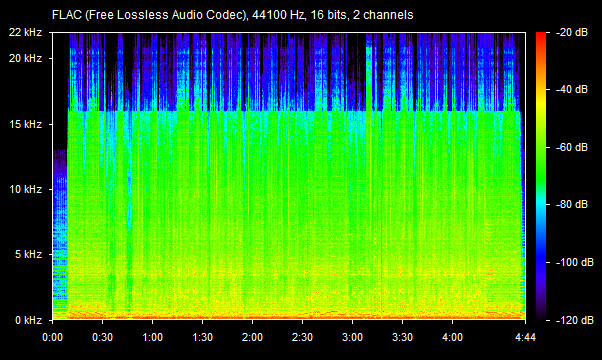
This is an enhanced youtube rip done as an experiment. Similar to the previous charts and other transcoded rips that sound worse then this. Note the blue on the top. Upon listening the music just as loud as a lossy 320 kbps but some of the audio quality has noticeable fade or sounds a bit staticy. Although i find this can sound better using a speaker compared to headphones on a listening preceptive at least to me. I tend to do with these rips and I usually keep them temporarily until im able to find a legit one to buy. Note i do not condone the use of sharing YouTube rips. If you want something off youtube rip it yourself.
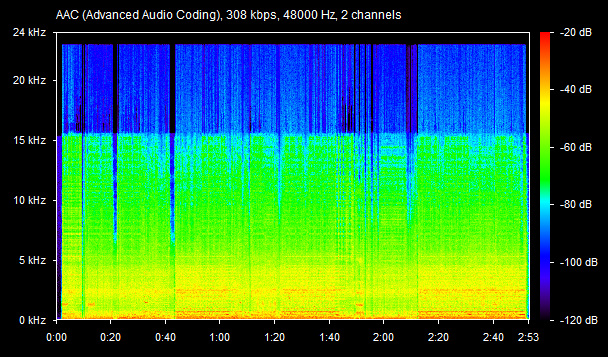
Heres another example but more of a legit rip. Note the blue.
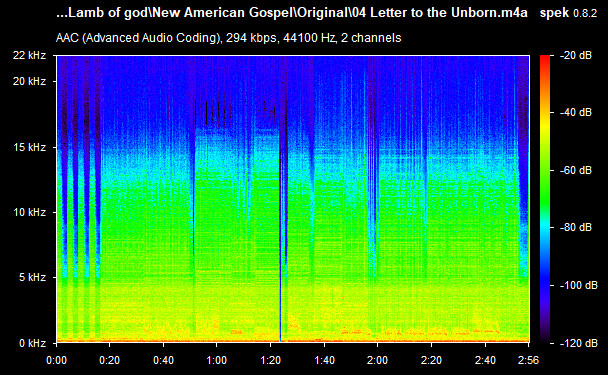
People generally go by the rule as in the higher the chart the better the rip. Which is true in most cases. but not always true because these all vary based on the production quality as mentioned previously. The general scale of how i read these charts are below:
Above 20 khz - Considered closest to lossless audio or lossless audio
17 khz to 20 khz - True lossy audio 192 kbps to 320 kbps
16 khz to 17 khz - Lossy audio 160 kbps to 192 kbps
15 khz to 16 khz - Lossy audio 128 kbps to 160 kbps
Less then 15 khz - Lossy audio 0 kbps to 128 kbps
This will vary on a listening perspective based on the colors chart to the right. Generally spek reads these really well if you know what your doing of course. Also note the HZ on the top every CD rip will always spek as 44100 Hz unless professionally altered to be higher otherwise.
I wont speak on demo rips they generally have a bit more involved with those. Things i dont generally have knowledge about.
Overall wanted to point out some extra things but definitely a good explanation. @zeus
This is all true. But in general, it’s too complicated and subjective to sit there and determine whether one picture is telling you everything, and if that picture hasn’t been doctored up. If you know what to look for, you can spot it. Most people do not. It’s far easier to just use the EAC LOG to verify that the CD was ripped properly than to read the tea leaves of Spek.
But that’s not to say Spek is useless. It’s very useful for doing the work that you described doing, as well as a myriad of other applications where having a visible waveform is useful. It’s just not useful for assessing the quality of a rip in a vacuum. That’s why I want to transition the scene into using LOG + CUE instead of Spek.
I agree it can be generally easier when it comes to figuring legit rips yes but this always will not be a standard that everyone will follow because in order to get a log or cue you need the CD itself and digital implementations are becoming more popular. I would be nice to use LOG and cues for people who do not know.
That’s why we have to normalize it now. This is something that happens across many other circles too. Anything released digitally is an exception to this, because that is distributed on an as-is basis and you get what you get. If you actually have the CD, then generate the LOG + CUE.
But from years of experience, I can testify that people rarely ever have issues with music distributed digitally. I have had one notable experience with this - the initial upload of 9GBO’s TANATOS on iTunes had the volume set very low - but usually these issues are rectified and the new files can always be acquired later. The stuff that many cast doubt on dovetails nicely with music that’s only ever pressed to CD.
When it comes to exceptionally rare or obscure releases, it gives people confidence that the job was done correctly if it comes with a LOG that tells you what settings were used to extract the files and whether they were legit or not. Let’s take the bootlegs of VARIOUS 会場限定盤 (Black VARIOUS) as an example. If someone with the actual CD ripped the CD using Exact Audio Copy and added the CRC hashes of each song to the AccurateRip database, then anyone with a legit copy of VARIOUS 会場限定盤 can rip their CD and get the same hashes. Anyone with a fake copy of VARIOUS 会場限定盤, where it was smashed together with transcoded MP3’s of THE SILENT SONG and 記憶、紺碧の微笑み, would rip their copy and compare the CRCs against what’s in AccurateRip, and you would instantly get a warning that the contents are not the same. You could use Spek to compare the wave forms and point out the inconsistencies, but it’s a less direct, more subjective method of accomplishing the same goals.
It will take time to wind down use of Spek, and sometimes there may be cases where it’s will be useful to have. But when it comes to verifying the authenticity of whatever files you may acquire, a LOG is your best friend. No one should object to generating one if asked unless they don’t have the CD or they have other ulterior motives which would require them to conceal the fact that they own the CD…which is honestly petty and childish because most of us are beyond that here.
And it’s also not a huge technical lift. It’s a few button clicks in EAC to do both. The hardest part of the entire thing is actually acquiring said CD.
I agree that i generally do not have problems with digital purchases unless i get it from amazon lol they suck. In either case i have bought from itunes with no issues but i mostly use otoyto to buy digital stuff.
In the case like the fake dimlim rip. It was a weird situation ill admit. I would say in this case only, spek would be wrong but then again all that blue looked a bit fishy to me but what really made me scepticale was the name. I double checked to see if they ever officially release anything similar. Black Various? Various doesn’t have that many tracks. It looked really thrown together and i was able to tell by listening and the overall presentation of the file itself.

I took a look at the fake rip and compared the transcoded rip by listening to both tracks of the 記憶、紺碧の微笑み rips as well as their rip charts and they are similar in sound. The fake rips sounds slightly higher but still transcoded. As a result, i concluded the rip was enhanced but poorly done similar to my example youtube enhanced rip above. Overall i do see your point about the fake rips. I have never came across this until now.
I agree that i generally do not have problems with digital purchases unless i get it from amazon lol they suck. In either case i have bought from itunes with no issues but i mostly use otoyto to buy digital stuff.
Yep, and that’s what ultimately makes me skeptical about using Spek for specifically this purpose. That counterfeit version of VARIOUS was done intentionally, and I’m wondering if the bootlegger manipulated the files even further so that it passed the sniff test. That’s not what mine looks like.
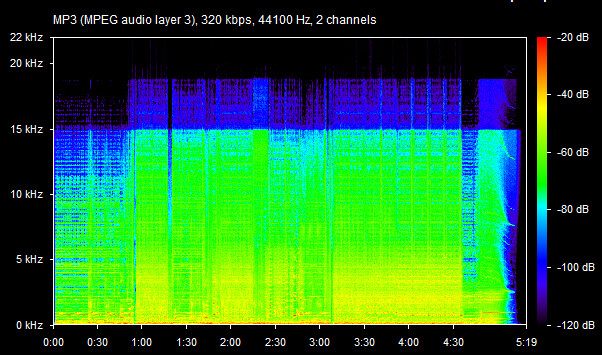
The green and the blue just don’t line up, and one pass of the MP3 encoder alone wouldn’t explain that. That file was mangled. But even so, we still need to take two separate charts and compare them in order to make this discovery. One chart alone isn’t enough to draw any solid conclusions. And then ultimately, there’s no guarantee that what I have isn’t a transcode either! I have no way to prove it isn’t. What if someone comes through with a third graph and it’s completely different looking? This complicates the problem further, and ultimately each listener will have to make a decision with incomplete information. LOG avoids this altogether - if the LOG says it’s good, then it’s good, and there’s a checksum at the end of the LOG so you can check if it’s altered or not.
There’s no way anyone is gonna forge a successful log, even if I explain how the sausage is made. There’s a tool that comes with EAC that checks if a log has been altered in the EAC folder called “CheckLog.exe”.
Open Notepad, paste in the code below, save it as CheckLog.bat on your Desktop. Obviously provide the path to EAC if you installed it somewhere else.
@echo off
"C:\Program Files (x86)\Exact Audio Copy\CheckLog.exe" %1
pause
Now all you have to do is drag and drop a LOG file on it to check it. If you want to do multiple log files, you can save this to another file.
@echo off
if [%1]==[] goto :eof
:loop
echo Checking %1:
"C:\Program Files (x86)\Exact Audio Copy\Checklog.exe" %1
echo.
echo.
shift
if not [%1]==[] goto loop
pause
If you have EAC installed, you can test the LOG file I have provided and you can verify that I altered it.

The time it takes to get a setup going to verify logs instantly is minimal. The amount of effort you would have to go through to fake a LOG is herculean. Easy to verify, hard to fake, and I altered the LOG above specifically because I know few would bother to make sure it was good. It was just taken as correct at first glance.
Don’t guess, know.
Im aware it was done intentionally. I honestly laughed at the file when i saw it. The reason i compared 2 charts was just to make sure because on the FLAC file i posted and the m4a came out really well for some odd reason when i exported it but other then that. The one chart you have above doesn’t have any cyan or green where the blue is. This makes it transcoded and lacks in the proper CD quality.

I agree but this all go by the green and cyan on a listening stand point. I know what you mean but my opinion based off most of the files i have come across transcoded files can be easy to spot by listening to track and also looking at the chart knowing how to read it yes in some cases it will not always be the case that the file seems transcoded but its not. In most cases the rules i mentioned above are true it is unless the production is bad. Like the OZ rip you provided or Xecstage - No going back. And even still sometimes the graph is high and it sounds trash similar to some of the luzmelt releases. Overall if you cant tell with a chart and things dont add up listen to it will paint a picture on the band production quality.
I did not care for The Godfather.
Is it bad that I found 12012 better than SADIE?
totally agree with you on this one! it took me a while to like mad game but i did love the rest of the songs on the album right away! i love the entirety of ugly heaven as well and am so excited for them to continue to release music ![]() i miss dadaroma but honestly the madna is quickly filling the hole in my heart LOL
i miss dadaroma but honestly the madna is quickly filling the hole in my heart LOL

I’m back with another uncommon unpopular opinion. No s’mores for this one because it’s not very incendiary, but perhaps it will make you think.
I came to the conclusion that our perception of 90’s visual kei is partially skewed by the poor quality lots of music and videos were recorded and preserved in, much like associating the faint cracks and pops of an old Miles Davis records with the 40’s-50’s, or how the colors of the Mona Lisa have changed over time. 1999 isn’t that long ago, but it sure feels like it! YouTube didn’t exist, everything was P2P, CRTs were everywhere and output was geared around it, 480p was considered HD and downloading a music video back then would take hours. When really old music videos pop up on my YouTube feed, visual kei or not, it takes me back in time in some fashion. When I’m watching Dir en grey PV’s from 2000, that grainy 360p texture that washes out all the details and imparts an aesthetic of it’s own is exactly how I saw it back then too, except in my head all the detail was crisp as hell. I’m so used to the macroblocking and smudging that it’s become a core part of the experience for me, and having the opportunity to experience it in high quality thanks to upscaling is a shock - and it’s one of the few areas of the scene left for me to genuinely experience something new.
Basically, the conditions that artists recorded under and intended for us to hear or view in a certain way is definitely not the way we’re experiencing it now. This led me to believe that the reality of the scene back then is different, not necessarily better or worse. We have what we have and I’d rather have that than nothing, but it is interesting to think about!
I mentioned in an earlier post about how physical media has a certain lifespan after which the music can no longer be retrieved from the medium. What I left out (because it was unimportant) is that the quality of the music on the medium degrades too. Dust particles, tape damage, CD scratches, and bit rot are all things that can affect the final product years after it was pressed to disc, tape, whatever. Someone who has no context as to how the song should sound will end up loving all of the imperfections in their copy for what they are…maybe those imperfections pop up in a cover of the track in the future! It’s interesting how music can take on a life of it’s own long after the artist has finished up.
Transgya community in japan (50+ ladies who will kill you if you will stare at their favorite band member for too long…) as toxic as western twitterians community
I want to personally thank @Cantavanda for his immense work to restore and preserve the Malice Mizer digital library.
Doing more to preserve the legacy of MM than any record label or favorite porcelain expressionless goth bandoman.
@TAAVI
Ooooh I just saw this!! Thank you very much for your nice comment!! I appreciate it a lot!!
All credit goes to the amazing bands of course!!
And I’m sure that if I didn’t do it, someone else would just around the same time!! I just became fan on the exact right time when computers were just strong and accessible enough for these kinds of things! I also got a little unfair boost in the YT algorithm from my 2012-2015 gaming videos subscribers!! XD
(I bet they all unsubbed after the drastic content change LOOL!)
But it’s been amazing to see how huge the fanbase has become since I started uploading the videos. In 2014… Visual Kei was considered dead by many! Fast forward 7 years later, and a ton of new young fans have joined, and older fans come back, AND many bands make a comeback! From popular bands such as deadman, and MM’s concert, and KAMIJO’s LAREINE concert, to super unknown bands like DIE:QUAR and Madame Rochas that are all coming back. It’s astonishing.
By the way: Soon will be a good time for my channel… Since I recently got a super good, professional Japanese VCR! But I’m so confused how to connect it to my modern Windows 10 PC, and I’m still figuring out how to capture its signal in lossless quality. Once everything is installed, it’ll also be summer vacation for me (college student), and I’ll upload VHS rips multiple times per week!! Can’t wait for that. The VCR is the best of the best when it comes to quality, and even has a built-in TBC, a special kind!
I currently have over 150 Japanese VK VHS tapes! A lot haven’t seen the light of day on YT yet, so I’m quite pumped to provide it.